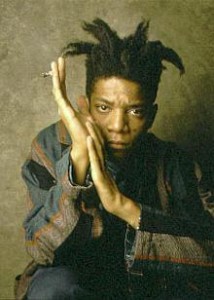b. Brooklyn, N.Y. Born into a middle-class Haitian and Puerto Rican family, he was a 1980s art star whose rise and fall were rapid and dramatic. A rebel, high school dropout, and part of the downtown New York scene, he was influenced by the violence of street life and by the life and work of Andy Warhol, who became his mentor.
Basquiat started as a graffiti artist, making images and writing slogans on the walls of buildings, and also produced painted T-shirts, found-object assemblages, and paintings.
In the early 1980s he was ‘discovered’ by the art establishment, and his works in paint and crayon on unprimed canvas, featuring crude, angry, and rawly powerful figures and graffiti-like written messages, were much sought after by collectors.
Basquiat’s art focused on “suggestive dichotomies,” such as wealth versus poverty, integration versus segregation, and inner versus outer experience. Basquiat appropriated poetry, drawing and painting, and married text and image, abstraction and figuration, and historical information mixed with contemporary critique.
Basquiat used social commentary in his paintings as a “springboard to deeper truths about the individual”, as well as attacks on power structures and systems of racism, while his poetics were acutely political and direct in their criticism of colonialism and support for class struggle.
He died of a heroin overdose at the age of 27.
